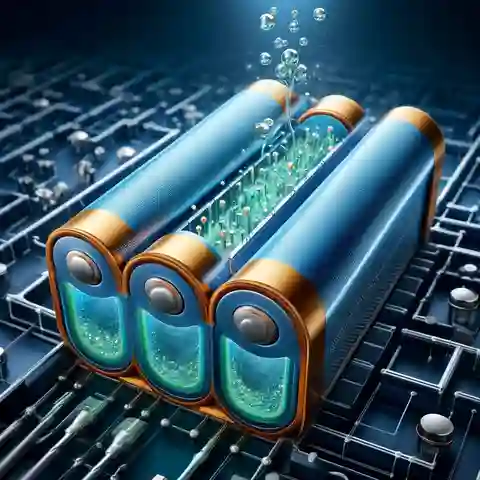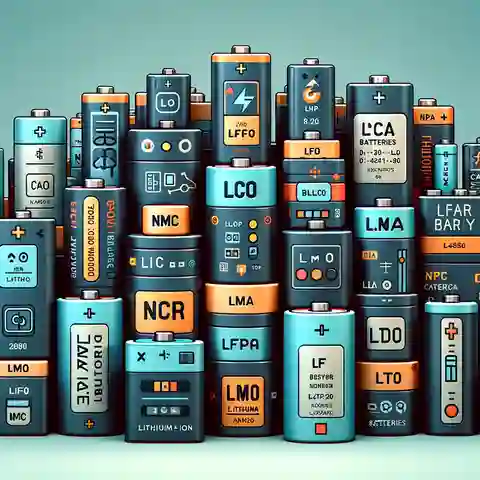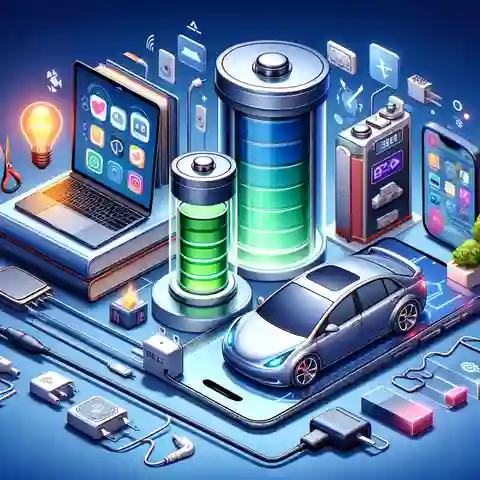Different types of lithium ion batteries – Imagine a world without smartphones, laptops that last all day, or zippy electric cars. It might sound a bit dull, right? These modern marvels owe their existence to a superstar of the energy world: the lithium-ion battery.
These rechargeable powerhouses have taken over the battery market thanks to their impressive energy storage, long lifespans, and the fact they barely lose charge when not in use.
So, what’s the secret behind their success? It all comes down to tiny charged particles called lithium ions. Inside a lithium-ion battery, these ions dance between two electrodes (one positive, one negative).
6 Different Types of Lithium ion Batteries and Characteristics
Each battery type is with its own special powers. Here’s the different types of lithium ion batteries:
1. Lithium Cobalt Oxide (LCO): The Pioneer
These were the original rockstars, squeezing lots of energy into a tiny size. But, they get tired faster than some newer types and need extra safety features. You’ll find them in older phones and some special gadgets.
2. Lithium Nickel Manganese Cobalt Oxide (NMC):
The All-Arounder Think of NMCs like the well-rounded athlete. They’ve got good energy, decent power, and last quite a while. This type powers lots of electric cars and your power tools at home.
3. Lithium Nickel Cobalt Aluminum Oxide (NCA):
The Energy Champ These pack a serious energy punch! They last a long time too. The downside? They’re more expensive and need careful watching. Think high-performance electric cars, like Teslas, using these.
4. Lithium Iron Phosphate (LFP): The Safe and Reliable
LFPs are like the marathon runners of batteries. Super safe and they last for aaages. They don’t hold quite as much energy for their size, but they’re getting better all the time. You’ll find them in electric buses and those giant power storage systems.
5. Lithium Manganese Oxide (LMO):
The Steady Helper LMOs do a decent job with energy and handle heat well. They aren’t superstars alone, so they’re often teamed up with NMC batteries for an extra boost.
6. Lithium Titanate (LTO):
The Extreme Specialist Need a battery that works in freezing cold space or charges super fast? LTOs to the rescue! They last practically forever. The catch – they’re pricey and don’t hold as much energy as others. Think satellites and some fancy electric cars.
Why are lithium-ion batteries so popular ?

Here’s a why lithium-ion batteries reign supreme in the world of portable electronics:
- High Energy Density: They pack a serious punch in a small package! This means longer runtimes for your phone or powering a slim laptop without a bulky battery.
- Low Self-Discharge: Unlike older batteries, lithium-ion batteries hold their charge well when not in use. You won’t find your phone mysteriously dead after a few days in your pocket.
- Long Lifespan: These batteries can handle lots of charge and discharge cycles before wearing out. This translates to years of reliable use from your devices.
- No “Memory Effect”: You can top up a lithium-ion battery anytime without harming its capacity (unlike some older battery types that needed to be fully drained first).
How Batteries Get Their Power (and Lose It!)
- Charging Up: Imagine those tiny lithium ions like a crowd of people. When you plug in your battery, it’s like pushing the crowd from one side to the other. They store energy as they get crammed onto the negative side.
- Powering Your Stuff: When you use your phone, it’s like opening the gates! The lithium ions rush back to the positive side, releasing their stored energy to run everything.
Do lithium-ion batteries have any drawbacks or safety concerns?
- Pricey Parts: Making lithium-ion batteries costs more than older types. That’s why your gadgets might cost a little extra too.
- Safety Worries: Sometimes, if a battery gets damaged or too hot, it can get way too hot (even catch fire). Scientists are always making batteries safer, but it’s something to be careful about.
- They Don’t Last Forever: Every time you charge and use your battery, it wears out a tiny bit. Eventually, it won’t hold as much power.
- Taking Care of the Planet: Getting the stuff to make these batteries can hurt the environment. Also, tossing them in the trash is bad news!
- Temperature Troubles: Batteries hate being super hot or freezing cold. It makes them work worse and age faster.
Good News! Scientists are always working on better batteries! They’re finding ways to make them cheaper, safer, longer-lasting, and easier on the planet.
Understanding Performance Differences

Think of batteries like different kinds of athletes. Some are sprinters, others are marathon runners, and some are built for lifting heavy weights. Here’s how to tell them apart:
Energy Density: The Long-Distance Runner
This tells you how much energy a battery stores compared to its size and weight. High energy density means longer runs (like your phone lasting all day) or smaller batteries for the same job.
Power Density: The Sprinter
This is all about how fast a battery can burst out with energy. Electric cars need good power density for zoom-zoom quick starts!
Lifespan: How Many Races They Can Run
Batteries get tired too! Lifespan is measured in cycles (how many times you can fully charge and drain it). A long lifespan means your battery keeps going for years and years.
Safety: Playing it Safe
Some batteries have a bit of a temper and need careful handling to avoid overheating. Safety features and sturdy construction are super important, especially in powerful batteries.
Cost: The Price of Power
Making batteries can get expensive! Fancy materials and complex designs mean some types cost way more than others.
The “best” battery isn’t always the one that wins in every category. It’s about what matters most for the job it’s doing!
Applications and Choosing the Right Battery

The world of batteries isn’t one-size-fits-all. Let’s see how different needs mean different batteries:
- Consumer Electronics: Phones, laptops, and gadgets need batteries that squeeze lots of energy into a small space and last a long time between charges.
- Electric Vehicles: It’s all about finding the right mix. Do you need maximum range (energy density), speedy acceleration (power density), safety features, and an affordable price tag? Carmakers juggle these factors based on the type of vehicle they’re building.
- Energy Storage Systems: Think of those giant batteries storing power for towns or solar farms. These need to last for ages, be super safe, and not cost a fortune.
- Specialty Applications: Sending a satellite into space? Operating in freezing temperatures? Maybe needing crazy-fast charging? This is where extra-tough batteries like LTOs shine, even if they cost more.
How Long Do Batteries Live?

- Cycles Matter: Most batteries can be fully charged and drained hundreds, even thousands of times.
- Things that Shorten Battery Life:
- Extreme heat or cold
- Letting the battery die completely all the time
- Storing the battery full for ages without using it
Can Batteries Be Recycled?
- Yes, but It’s Tricky: Special places can get the valuable stuff out of old batteries to use again. Recycling is getting way more common!
- Trashing Batteries = Bad: They have stuff inside that’s bad for the environment. Find special places to recycle old batteries instead of tossing them!
Conclusion
Scientists are always cooking up new recipes for even better batteries! They’re working on making them smaller, mightier, safer, and cheaper. Who knows, maybe one day your phone will last a whole month on a single charge!
